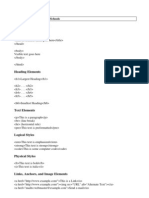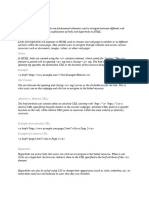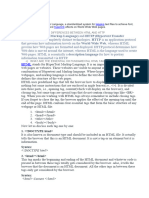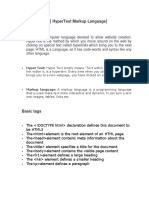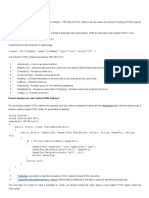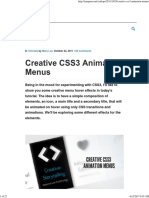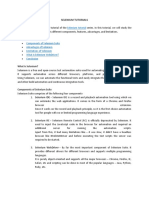Complete Web Development Guide - HTML, CSS, XML & XHTML
UNIT-I: HTML (HyperText Markup Language)
What is HTML?
HTML is like the skeleton of a webpage. It tells the browser what content to display and how to
structure it. Think of it as the blueprint of a house - it defines where everything goes.
Basic Syntax
HTML uses tags to mark up content. Tags are keywords surrounded by angle brackets:
html
<tagname>Content goes here</tagname>
Key Rules:
Most tags come in pairs: opening <tag> and closing </tag>
Closing tags have a forward slash /
Some tags are self-closing: <br> , <img> , <hr>
Standard HTML Document Structure
Every HTML page follows this basic structure:
html
<!DOCTYPE html>
<html>
<head>
<title>Page Title</title>
</head>
<body>
<!-- Your content goes here -->
</body>
</html>
Breakdown:
<!DOCTYPE html> - Tells browser this is HTML5
<html> - Root element containing everything
<head> - Contains information about the page (not visible to users)
<title> - Shows in browser tab
<body> - Contains all visible content
Basic Text Markup
Common Text Tags:
<h1> to <h6> - Headings (largest to smallest)
<p> - Paragraphs
<br> - Line break
<strong> or <b> - Bold text
<em> or <i> - Italic text
<u> - Underlined text
<small> - Smaller text
<mark> - Highlighted text
Example:
html
<h1>Main Heading</h1>
<p>This is a <strong>bold</strong> paragraph with <em>italic</em> text.</p>
HTML Styles
You can add basic styling directly to HTML elements using the style attribute:
html
<p style="color: blue; font-size: 18px;">This is blue text</p>
Common Style Properties:
color - Text color
background-color - Background color
font-size - Text size
font-family - Font type
text-align - Text alignment
Elements and Attributes
Elements are the building blocks (like <p> , <h1> , <img> )
Attributes provide additional information about elements:
html
<img src="photo.jpg" alt="A beautiful sunset" width="300" height="200">
Common Attributes:
id - Unique identifier
class - Group identifier for styling
src - Source file path
alt - Alternative text
href - Link destination
title - Tooltip text
Headings
Six levels of headings for organizing content:
html
<h1>Main Title</h1>
<h2>Chapter Title</h2>
<h3>Section Title</h3>
<h4>Subsection</h4>
<h5>Minor Heading</h5>
<h6>Smallest Heading</h6>
Layouts
HTML5 provides semantic elements for better page structure:
html
<header>Top of page content</header>
<nav>Navigation menu</nav>
<main>
<section>Main content section</section>
<article>Individual article</article>
<aside>Sidebar content</aside>
</main>
<footer>Bottom of page content</footer>
Iframes
Iframes embed other web pages within your page:
html
<iframe src="https://www.example.com" width="600" height="400"></iframe>
Common Uses:
Embedding YouTube videos
Displaying maps
Including external content
Images
Display pictures on your webpage:
html
<img src="image.jpg" alt="Description" width="300" height="200">
Key Attributes:
src - Image file path
alt - Description for screen readers
width/height - Size control
title - Hover tooltip
Hypertext Links
Create clickable links:
html
<a href="https://www.example.com">Visit Example</a>
<a href="page2.html">Go to Page 2</a>
<a href="#section1">Jump to Section 1</a>
<a href="mailto:someone@example.com">Send Email</a>
Link Types:
External links (other websites)
Internal links (same website)
Anchor links (same page)
Email links
Lists
Unordered Lists (bullets):
html
<ul>
<li>First item</li>
<li>Second item</li>
<li>Third item</li>
</ul>
Ordered Lists (numbers):
html
<ol>
<li>First step</li>
<li>Second step</li>
<li>Third step</li>
</ol>
Description Lists:
html
<dl>
<dt>Term</dt>
<dd>Definition</dd>
</dl>
Tables
Display data in rows and columns:
html
<table>
<thead>
<tr>
<th>Name</th>
<th>Age</th>
<th>City</th>
</tr>
</thead>
<tbody>
<tr>
<td>John</td>
<td>25</td>
<td>New York</td>
</tr>
<tr>
<td>Jane</td>
<td>30</td>
<td>London</td>
</tr>
</tbody>
</table>
Table Elements:
<table> - Container
<thead> - Header section
<tbody> - Body section
<tr> - Table row
<th> - Header cell
<td> - Data cell
Forms
Collect user input:
html
<form action="submit.php" method="post">
<label for="name">Name:</label>
<input type="text" id="name" name="name" required>
<label for="email">Email:</label>
<input type="email" id="email" name="email" required>
<label for="message">Message:</label>
<textarea id="message" name="message"></textarea>
<input type="submit" value="Submit">
</form>
Form Input Types:
text - Single line text
email - Email address
password - Hidden text
number - Numbers only
date - Date picker
radio - Single choice
checkbox - Multiple choices
file - File upload
Dynamic HTML
Dynamic HTML combines HTML with CSS and JavaScript to create interactive content:
Examples:
Dropdown menus
Image slideshows
Form validation
Content that changes without page reload
CSS (Cascading Style Sheets)
Need for CSS
Problems CSS Solves:
HTML alone creates plain, boring pages
Mixing content with presentation makes code messy
Hard to maintain consistent styling across multiple pages
Limited design flexibility with HTML alone
Introduction to CSS
CSS is like the interior designer for your HTML house. While HTML provides structure, CSS makes it
beautiful by controlling:
Colors and fonts
Layout and spacing
Animations and effects
Responsive design
Basic Syntax and Structure
CSS Rule Structure:
css
selector {
property: value;
property: value;
}
Example:
css
h1 {
color: blue;
font-size: 24px;
text-align: center;
}
Parts Explained:
h1 - Selector (what to style)
color: blue; - Declaration (how to style)
color - Property
blue - Value
Using CSS
Three Ways to Add CSS:
1. Inline CSS (directly in HTML):
html
<p style="color: red;">Red text</p>
2. Internal CSS (in HTML head):
html
<head>
<style>
p { color: red; }
</style>
</head>
3. External CSS (separate file):
html
<head>
<link rel="stylesheet" href="styles.css">
</head>
Background Images, Colors, and Properties
Background Colors:
css
body {
background-color: lightblue;
}
Background Images:
css
body {
background-image: url('background.jpg');
background-repeat: no-repeat;
background-position: center;
background-size: cover;
}
Background Properties:
background-color - Solid color
background-image - Image background
background-repeat - How image repeats
background-position - Image placement
background-size - Image size
Manipulating Text
Text Properties:
css
p {
color: navy;
text-align: center;
text-decoration: underline;
text-transform: uppercase;
line-height: 1.5;
letter-spacing: 2px;
word-spacing: 5px;
}
Text Styling Options:
color - Text color
text-align - Alignment (left, center, right, justify)
text-decoration - Underline, overline, line-through
text-transform - uppercase, lowercase, capitalize
line-height - Space between lines
letter-spacing - Space between letters
word-spacing - Space between words
Using Fonts
Font Properties:
css
h1 {
font-family: Arial, sans-serif;
font-size: 24px;
font-weight: bold;
font-style: italic;
}
Font Options:
font-family - Font type
font-size - Text size
font-weight - Thickness (normal, bold, 100-900)
font-style - Normal, italic, oblique
Web Safe Fonts:
Arial, Helvetica, sans-serif
Georgia, serif
"Times New Roman", serif
"Courier New", monospace
Borders
Border Properties:
css
div {
border: 2px solid black;
border-radius: 10px;
}
Detailed Border Control:
css
div {
border-width: 2px;
border-style: solid;
border-color: red;
/* Individual sides */
border-top: 1px dotted blue;
border-right: 2px dashed green;
border-bottom: 3px solid yellow;
border-left: 4px double purple;
}
Boxes, Margins, and Padding
The Box Model: Every HTML element is a box with:
Content (the actual content)
Padding (space inside the box)
Border (line around the box)
Margin (space outside the box)
css
div {
width: 200px;
height: 100px;
padding: 20px;
border: 5px solid black;
margin: 10px;
}
Margin and Padding Shortcuts:
css
/* All sides */
margin: 10px;
/* Top/bottom, left/right */
margin: 10px 20px;
/* Top, left/right, bottom */
margin: 10px 20px 15px;
/* Top, right, bottom, left */
margin: 10px 20px 15px 25px;
Lists Styling
List Properties:
css
ul {
list-style-type: circle;
list-style-position: inside;
list-style-image: url('bullet.png');
}
ol {
list-style-type: upper-roman;
}
Remove List Bullets:
css
ul {
list-style: none;
}
Positioning Using CSS
Position Types:
1. Static (default):
css
div { position: static; }
2. Relative (relative to normal position):
css
div {
position: relative;
top: 10px;
left: 20px;
}
3. Absolute (relative to nearest positioned parent):
css
div {
position: absolute;
top: 0;
right: 0;
}
4. Fixed (relative to viewport):
css
div {
position: fixed;
bottom: 0;
right: 0;
}
5. Sticky (switches between relative and fixed):
css
div {
position: sticky;
top: 0;
}
CSS2 Features
CSS2 introduced:
Better positioning
Media types for different devices
Downloadable fonts
Table layout properties
Counters and generated content
The Box Model (Detailed)
Standard Box Model: Total width = width + padding + border + margin
Box-sizing Property:
css
/* Standard box model */
div {
box-sizing: content-box;
}
/* Alternative box model */
div {
box-sizing: border-box;
}
Working with XML
What is XML?
XML (eXtensible Markup Language) is like HTML but for storing and transporting data. While HTML
displays data, XML describes data.
Key Differences from HTML:
XML tags are custom-made
XML is case-sensitive
All XML tags must be properly closed
XML focuses on data, not presentation
XML Example:
xml
<?xml version="1.0" encoding="UTF-8"?>
<bookstore>
<book id="1">
<title>Learning XML</title>
<author>John Doe</author>
<price>29.99</price>
</book>
</bookstore>
Document Type Definition (DTD)
DTD defines the structure and rules for an XML document. It's like a blueprint that says what elements
are allowed.
Internal DTD:
xml
<?xml version="1.0"?>
<!DOCTYPE bookstore [
<!ELEMENT bookstore (book+)>
<!ELEMENT book (title, author, price)>
<!ELEMENT title (#PCDATA)>
<!ELEMENT author (#PCDATA)>
<!ELEMENT price (#PCDATA)>
]>
<bookstore>
<!-- XML content here -->
</bookstore>
External DTD:
xml
<?xml version="1.0"?>
<!DOCTYPE bookstore SYSTEM "bookstore.dtd">
<bookstore>
<!-- XML content here -->
</bookstore>
XML Schemas
XML Schema is a more powerful alternative to DTD. It provides:
Data type support
Better validation
Namespace support
XML Schema Example:
xml
<xs:schema xmlns:xs="http://www.w3.org/2001/XMLSchema">
<xs:element name="book">
<xs:complexType>
<xs:sequence>
<xs:element name="title" type="xs:string"/>
<xs:element name="author" type="xs:string"/>
<xs:element name="price" type="xs:decimal"/>
</xs:sequence>
</xs:complexType>
</xs:element>
</xs:schema>
Document Object Model (DOM)
DOM is a way to represent XML/HTML documents as a tree structure in memory. It allows programs to
access and modify the document.
DOM Tree Structure:
Document
├── Root Element
├── Element
│ ├── Text
│ └── Attribute
└── Element
└── Text
DOM Methods:
getElementById() - Find element by ID
getElementsByTagName() - Find elements by tag
createElement() - Create new element
appendChild() - Add child element
Parsers - DOM and SAX
DOM Parser:
Loads entire document into memory
Creates tree structure
Good for small documents
Allows random access to any part
SAX Parser (Simple API for XML):
Reads document sequentially
Event-driven (triggers events for each element)
Memory efficient
Good for large documents
Only forward reading
When to Use Which:
Use DOM for small files that need modification
Use SAX for large files that only need reading
Introduction to XHTML
What is XHTML?
XHTML (eXtensible HyperText Markup Language) is HTML written according to XML rules. It's stricter
than HTML.
Key Differences from HTML:
All tags must be closed
All tags must be lowercase
Attribute values must be quoted
All attributes must have values
HTML vs XHTML:
html
<!-- HTML (more forgiving) -->
<p>This is a paragraph
<br>
<input type="text" name="username">
<!-- XHTML (strict) -->
<p>This is a paragraph</p>
<br />
<input type="text" name="username" />
XML in XHTML
XHTML follows XML syntax rules:
XHTML Document Structure:
xml
<?xml version="1.0" encoding="UTF-8"?>
<!DOCTYPE html PUBLIC "-//W3C//DTD XHTML 1.0 Strict//EN"
"http://www.w3.org/TR/xhtml1/DTD/xhtml1-strict.dtd">
<html xmlns="http://www.w3.org/1999/xhtml">
<head>
<title>XHTML Page</title>
</head>
<body>
<p>Content goes here</p>
</body>
</html>
Meta Tags
Meta tags provide information about the HTML document:
html
<head>
<!-- Character encoding -->
<meta charset="UTF-8" />
<!-- Page description -->
<meta name="description" content="Page description here" />
<!-- Keywords for search engines -->
<meta name="keywords" content="HTML, CSS, XHTML" />
<!-- Author information -->
<meta name="author" content="Your Name" />
<!-- Viewport for responsive design -->
<meta name="viewport" content="width=device-width, initial-scale=1.0" />
<!-- Refresh page every 30 seconds -->
<meta http-equiv="refresh" content="30" />
</head>
Character Entities
Special characters in HTML/XHTML:
Common Entities:
< - Less than (<)
> - Greater than (>)
& - Ampersand (&)
" - Quotation mark (")
' - Apostrophe (')
- Non-breaking space
© - Copyright symbol (©)
® - Registered trademark (®)
Example:
html
<p>To display <HTML> tags, use &lt; and &gt;</p>
Frames and Frame Sets
Frames divide the browser window into multiple sections (mostly deprecated now):
Frameset Example:
html
<!DOCTYPE html>
<html>
<head>
<title>Frames Example</title>
</head>
<frameset cols="25%,75%">
<frame src="menu.html" name="menu" />
<frame src="content.html" name="content" />
</frameset>
</html>
Frame Attributes:
src - Source file
name - Frame name for targeting
scrolling - Enable/disable scrollbars
noresize - Prevent resizing
frameborder - Show/hide borders
Modern Alternative - Iframes:
html
<iframe src="content.html" width="800" height="600"></iframe>
Summary
This guide covers the fundamentals of web development:
HTML provides the structure and content of web pages using elements and attributes.
CSS handles the presentation and styling, making pages visually appealing and responsive.
XML is used for data storage and transport with strict syntax rules.
XHTML combines HTML with XML's strict syntax for cleaner, more maintainable code.
These technologies work together to create modern web applications. HTML provides the foundation,
CSS makes it beautiful, XML handles data, and XHTML ensures clean, valid markup.
Best Practices:
Always use proper document structure
Separate content (HTML) from presentation (CSS)
Validate your markup
Use semantic HTML elements
Keep CSS organized and maintainable
Follow accessibility guidelines
Test across different browsers and devices

























